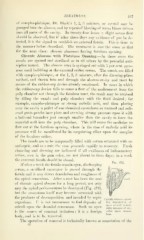Page 499 - My FlipBook
P. 499
TREATMENT. 497
of campho-phenique, Dr. Black's 1, 2, 3 mixture, or myrtol may be
pumped into the abscess, and by repeated blowing of warm blasts driven
into all parts of the cavity. In tw^enty-four hours a slight serous flow
should be observed, but if after three days any evidence of pus be de-
tected, it is the signal to establish an external fistula. This is done in
the manner before described. The treatment is now the same as that
for the next class : chronic abscesses having fistulous opening.
Chronic Abscess with Fistulous Opening-.—In these cases the
canals are opened and sterilized as in all others by the powerful anti-
septics named. The abscess tract is syringed out with 3 per cent, pyro-
zone until bubbling at the external orifice ceases. The canals are filled
with campho-phenique, or the 1, 2, 3 mixture, after the dressing-pliers
method, and drawn into and through the abscess cavity and tract by
means of the rubber-cup device already mentioned. In cases in which
the rubber-cup device fails to cause a flow of the medicament from the
pulp chamber out through the fistulous tract, the result may be attained
by filling the canals and pulp chamber wdth the fluid desired ; for
example, campho-phenique or strong carbolic acid, and then placing
over the cavity a pellet of unvulcanizcd caoutchouc or warmed and soft-
ened gutta-percha base plate and exerting strong pressure upon it with
a ball-end burnisher just enough smaller than the cavity to force the
material well into the pulp chamber. This will cause the medicine to
flow out at the fistulous opening, where in the case of carbolic acid its
presence will be manifested by its coagulating effect upon the margins
of the fistulous orifice.
The canals are to be temporarily filled with cotton saturated with an
antiseptic, and as a rule the case proceeds rapidly to recovery. Fresh
cleansing and dressing are indicated if all evidences of inflammatory
action, seen in the gum color, are not absent in three days ; in a week
the external fistula should be closed.
If after a week the fistula remain open, discharging
serum, a sterilized excavator is passed through the
fistula and it may detect denudation and roughness of
the apical cementum. After a root has been the seat
of chronic apical abscess for a long period, not only
may the apical pericementum be destroyed (Fig. 473),
but the cementum itself may become saturated with
the products of decomposition and invaded by septic
chronic abscess show-
:
organisms. It is not uncommon to find deposits of ing denudation of
!!• xijij J. 01 apex of root (a to 6),
calculi upon the denuded cementum. feuch an apex
^j^j^ deposits of cai-
is the source of constant irritation ; it is a foreign cuius upon cemen-
body, and is to be removed.
The operation of removal is technically known as amputation of the
32


